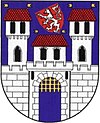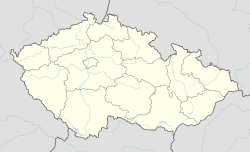Žatec
| Žatec | ||
|---|---|---|
| Municipality | ||

Main square with town hall
|
||
|
||
| Coordinates: 50°19′48″N 13°32′40″E / 50.33000°N 13.54444°ECoordinates: 50°19′48″N 13°32′40″E / 50.33000°N 13.54444°E | ||
| Country |
|
|
| Region | Ústí nad Labem | |
| District | Louny | |
| Area | ||
| • Total | 42.69 km2 (16.48 sq mi) | |
| Elevation | 233 m (764 ft) | |
| Population (2006) | ||
| • Total | 19,813 | |
| • Density | 460/km2 (1,200/sq mi) | |
| Postal code | 438 01 | |
| Website | http://www.mesto-zatec.cz/ | |
Žatec (Czech pronunciation: [ˈʒatɛts]; German: Saaz) is a historic town in Louny District, Ústí nad Labem Region, in the Czech Republic.
It is famous for an over-700-year-long tradition of growing Saaz noble hops used by several breweries. Žatec produces its own beer and hosts 'Dočesná', its (hops related) harvest festival every year on the town square.
The earliest historical reference to the Bohemian fortress of Sacz is in the Latin chronicle of Thietmar of Merseburg of 1004, when King Henry II of Germany reconquered it from the Polish duke Bolesław I Chrobry. During the 11th century it belonged to the Vršovci - a powerful Czech aristocratic family. It received the privileges of a royal town under King Ottokar II of Bohemia in 1265. A coat-of-arms was given to the citizens by King Vladislav II for their courage during the storming of Milan.
From the outbreak of the Hussite Wars in 1419 to the Thirty Years' War, the town was Hussite or Protestant, but after the Battle of White Mountain (1620) the greater part of the Czech inhabitants left the town, which remained German and Roman Catholic until 1945, when the German speaking inhabitants were forced to leave their home and emigrate to Germany.
...
Wikipedia


